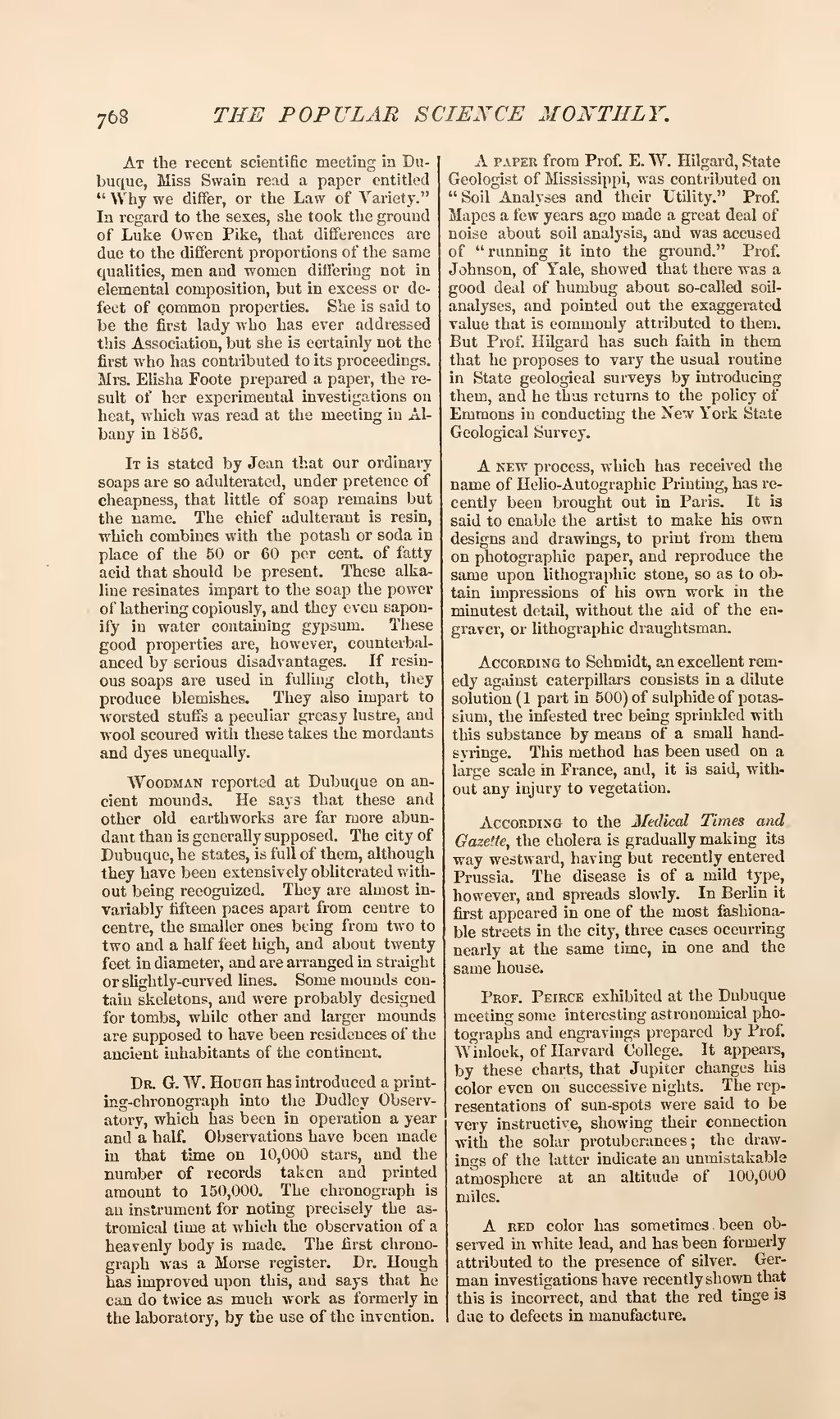At the recent scientific meeting in Dubuque, Miss Swain read a paper entitled "Why we differ, or the Law of Variety." In regard to the sexes, she took the ground of Luke Owen Pike, that differences are due to the different proportions of the same qualities, men and women differing not in elemental composition, but in excess or defect of common properties. She is said to be the first lady who has ever addressed this Association, but she is certainly not the first who has contributed to its proceedings. Mrs. Elisha Foote prepared a paper, the result of her experimental investigations on heat, which was read at the meeting in Albany in 1856.
It is stated by Jean that our ordinary soaps are so adulterated, under pretence of cheapness, that little of soap remains but the name. The chief adulterant is resin, which combines with the potash or soda in place of the 50 or 60 per cent, of fatty acid that should be present. These alkaline resinates impart to the soap the power of lathering copiously, and they even saponify in water containing gypsum. These good properties are, however, counterbalanced by serious disadvantages. If resinous soaps are used in fulling cloth, they produce blemishes. They also impart to worsted stuffs a peculiar greasy lustre, and wool scoured with these takes the mordants and dyes unequally.
Woodman reported at Dubuque on ancient mounds. He says that these and other old earthworks are far more abundant than is generally supposed. The city of Dubuque, he states, is full of them, although they have been extensively obliterated without being recognized. They are almost invariably fifteen paces apart from centre to centre, the smaller ones being from two to two and a half feet high, and about twenty feet in diameter, and are arranged in straight or slightly curved lines. Some mounds contain skeletons, and were probably designed for tombs, while other and larger mounds are supposed to have been residences of the ancient inhabitants of the continent.
Dr. G. W. Hough has introduced a printing-chronograph into the Dudley Observatory, which has been in operation a year and a half. Observations have been made in that time on 10,000 stars, and the number of records taken and printed amount to 150,000. The chronograph is an instrument for noting precisely the astromical time at which the observation of a heavenly body is made. The first chronograph was a Morse register. Dr. Hough has improved upon this, and says that he can do twice as much work as formerly in the laboratory, by the use of the invention.
A paper from Prof. E. W. Hilgard, State Geologist of Mississippi, was contributed on "Soil Analyses and their Utility." Prof. Mapes a few years ago made a great deal of noise about soil analysis, and was accused of "running it into the ground." Prof. Johnson, of Yale, showed that there was a good deal of humbug about so-called soil analyses, and pointed out the exaggerated value that is commonly attributed to them. But Prof. Hilgard has such faith in them that he proposes to vary the usual routine in State geological surveys by introducing them, and he thus returns to the policy of Emmons in conducting the New York State Geological Survey.
A new process, which has received the name of Helio-Autographic Printing, has recently been brought out in Paris. It is said to enable the artist to make his own designs and drawings, to print from them on photographic paper, and reproduce the same upon lithographic stone, so as to obtain impressions of his own work in the minutest detail, without the aid of the engraver, or lithographic draughtsman.
According to Schmidt, an excellent remedy against caterpillars consists in a dilute solution (1 part in 500) of sulphide of potassium, the infested tree being sprinkled with this substance by means of a small hand-syringe. This method has been used on a large scale in France, and, it is said, without any injury to vegetation.
According to the Medical Times and Gazette, the cholera is gradually making its way westward, having but recently entered Prussia. The disease is of a mild type, however, and spreads slowly. In Berlin it first appeared in one of the most fashionable streets in the city, three cases occurring nearly at the same time, in one and the same house.
Prof. Peirce exhibited at the Dubuque meeting some interesting astronomical photographs and engravings prepared by Prof. Winlock, of Harvard College. It appears, by these charts, that Jupiter changes his color even on successive nights. The representations of sun-spots were said to be very instructive, showing their connection with the solar protuberances; the drawings of the latter indicate an unmistakable atmosphere at an altitude of 100,000 miles.
A red color has sometimes been observed in white lead, and has been formerly attributed to the presence of silver. German investigations have recently shown that this is incorrect, and that the red tinge is due to defects in manufacture.

